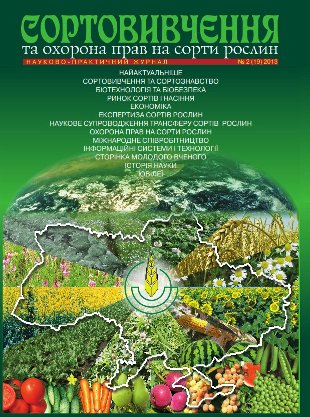Inheritance nature for the trait of resistance to neck rot in hybrid combinations of common onion under the conditions of Nosivka Variety Texting Station
DOI:
https://doi.org/10.21498/2518-1017.2(19).2013.58566Keywords:
common onion, variety, hybrid, resistance, pathogen, disease, neck rot, heritance rate.Abstract
The article highlights the results of studying hybrid combinations of common onion to the Botrytis allii Munn pathogen. It is found out that as for the combinations being studied the resistance to pathogen was inherited as dominant, intermediate or recessive trait. Better resistance to neck rot was inherent in the hybrid combinations which parents comprised resistant and immune varieties, insofar as the determination of inheritance coefficient has indicated F1 hybrids have this characteristic expression dependant by 50 to 78% on the parental plant (h2 =0,50–0,78). Studying the determination of the impact of both parental components on inheritance of the resistance to B. allii pathogen showed that the regression coefficient subject to hybrid combination fell within R = 0,12–0,39, while the resistance coefficient within 0,24–0,78, respectively. Efficiency of selection is proved by the trait of resistance to neck rot based on the populations of Grandina х Mavka, Olina х Grandina, Grandina х Skvyrska і Skvyrska х Grandina, as their respective inheritance coefficient reached the level of 0,42 to 0,78.Downloads
References
Куприенко, Н.П. Болезни лука в Белоруси. – Минск: Белпринс, 2005. – 128 с.
Alliums pp. FAO/IPGRI Technical Guidelines for the Safe Movement of Germplasm (ed. By M. Diekmann). – 1997. – No 18. – 59 p.
Куприенко, Н.П. Болезни лука репчатого в условиях Белоруси и разработка мер борьбы с ними: автореф. дис. на соискание уч. степени канд. с.-х. наук: спец. 06.01.11 «Защита растений от вредителей и болезней» / Н.П. Куприенко. – Минск, 1993. – 22 с.
Осницкая, Е.А. Шейковая гниль лука / Е.А. Осницкая. – М.: Государственное издательство с.-х. литературы, 1957. – 40 с.
Черненко, В. Результати імунологічних досліджень колекції вітчизняних сортів цибулі ріпчастої і метод добору джерел стійкості до Peronospora destructor / В. Черненко // Захист і карантин рослин. – 2006. – Вип. 52. – С. 326–330.
Методичні рекомендації по селекції овочевих рослин родини цибулевих / Т.В. Чернишенко, К.І. Яковенко, О.М. Біленька [та ін.] // Сучасні методи селекції овочевих і баштанних культур. – Харків, 2001. – С. 406–425.
Методические указания по селекции сортов и гетерозисных гибридов овощных культур / под. ред. академика ВАСХНИЛ Д.Д. Брежнева. – Л.: ВИР, 1974. – 217 с.
Методи визначення стійкості овочевих і баштанних культур проти основних хвороб і шкідників / В.В. Скляревська, В.М. Ковбасенко, В.Ф Переверзєва [та ін.] // Сучасні методи селекції овочевих і баштанних культур. – Харків, 2001. – С. 114–188.
Доспехов, Б.А. Методика полевого опыта / Б.А. Доспехов. – М.: Агропромиздат, 1985. – 350 с.
Драганцев, В.А. Методы оценки генотипической, генетической и экологической корреляций количественных признаков в растительной популяции / В.А. Драганцев // Генетический анализ количественных и качественных признаков с помощью математико-статистических методов. – М.: Колос, 1973. – С. 121–132.
Смиряев, А.В. Биометрические методы в селекции растений / А.В. Смиряев, М.В. Гохман. – М.: Агропромиздат, 1985. – 214 с.
Федин, М.А. Статистические методы генетического анализа / М.А. Федин, Д.Я. Силис, А.В. Смиряв. – М.: Колос, 1980. – 208 с.
Методические рекомендации по статистической оценке селекционного материала овощных и бахчевых культур. – Харьков, 1983. – 69 с.
Downloads
Published
How to Cite
Issue
Section
License
Copyright (c) 2013 Ukrainian Institute for Plant Variety Examination

This work is licensed under a Creative Commons Attribution-ShareAlike 4.0 International License.
Starting in 2022, the copyright to the publication remains with the authors
Our journal abides by the CREATIVE COMMONS copyright rights and permissions for open access journals.
Authors, who are published in this journal, agree to the following conditions:
- The authors reserve the right to authorship of the work and pass the first publication right of this work to the journal under the terms of a Creative Commons Attribution License, which allows others to freely distribute the published research with the obligatory reference to the authors of the original work and the first publication of the work in this journal.
- The authors have the right to conclude separate supplement agreements that relate to non-exclusive work distribution in the form in which it has been published by the journal (for example, to upload the work to the online storage of the journal or publish it as part of a monograph), provided that the reference to the first publication of the work in this journal is included.

























 Ukrainian Institute for Plant Varieties Examination
Ukrainian Institute for Plant Varieties Examination  Селекційно-генетичний інститут
Селекційно-генетичний інститут Institute of Plant Physiology and Genetics of the National Academy of Sciences of Ukraine
Institute of Plant Physiology and Genetics of the National Academy of Sciences of Ukraine
 The National Academy of Agrarian Sciences of Ukraine
The National Academy of Agrarian Sciences of Ukraine